St Albans Cathedral
| St Albans Cathedral | |
|
The Cathedral and Abbey Church of St Alban | |
|---|---|
|
St Albans, Hertfordshire | |
| Status: | catherdral |
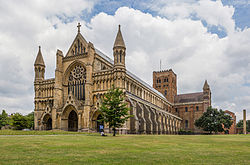 St Albans Cathedral viewed from the south west | |
| Church of England | |
| Diocese of St Albans | |
| Location | |
| Location: | 51°45’2"N, 0°20’32"W |
| History | |
| Built 1077–1893 | |
| Romanesque / Gothic | |
| Information | |
| Website: | stalbanscathedral.org.uk |
The Cathedral and Abbey Church of St Alban, commonly known as St Albans Cathedral, is the cathedral of the Diocese of St Albans, which serves Hertfordshire and Bedfordshire, and the seat of the Bishop of St Albans. It stands in the centre Hertfordshire’s county town, St Albans, which was raised to the status of a city when the church was elevated to be a cathedral in 1877. It also serves as a parish church for the city, which role it has fulfilled since the Reformation.
The cathedral, if not its status as such, is ancient, having been the the church of the old Benedictine abbey of St Alban. It dominates the little city and at 276 feet, its nave is the longest of any cathedral in the Church of England and overall St Albans is the second longest cathedral in the United Kingdom, exceeded only by Winchester). Much of its present architecture dates from Norman times, but it incorporates some details apparently reused from the Anglo-Saxon abbey raised by King Offa of Mercia and its tower is made of Roman bricks brought up the hill from the abandoned Roman city, Verulamium.
Locally the cathedral is known as 'St Albans Abbey', the name by which it was known when just the parish church for the town before it became a cathedral in 1877, though the mediæval abbey was a much wider complex of which the church and the vast gatehouse nearby are the main surviving structures.
Britain's first Christian martyr
The origin of the cathedral is found in the legend of St Alban, who is named as “the Protomartyr of Britain”. Alban was a Roman soldier living in the Roman city of Verulamium during the reign of Diocletian, a vigorous persecutor of Christians. Alban sheltered a fleeing Christian priest in his home and was converted to the Christian faith by him. When the soldiers came to Alban's house looking for the priest, Alban exchanged cloaks with the priest and let himself be arrested in his place. Alban was taken before the magistrate, where he avowed his new Christian faith and was condemned for it. He was led from the city across the River Ver and up the opposite hill, where he was beheaded, according to legend, on the spot where the cathedral named after him now stands. The site is on a steep hill and legend has it that his head rolled down the hill after being cut off and that a well sprang up at the point where it stopped. The legend is very early and possibly contempoarary with the evebnts – it is related by Gildas in the early sixth century, who adds that Alban crossed the river dryshod, having struck it with his cloak and parted the waters (although Gildas asserts the river was the Thames, showing an appreciation of Hertfordshire geography about as accurate that of most Hertfordshire folk would have of Gildas's Glamorgan).
A well certainly exists today and the road up to the cathedral is named Holywell Hill. However the current well structure is no older than the late 19th century and it is thought that the name of the street derives from the "Halywell" river and "Halywell Bridge", not from the well.[1]
The date of Alban's execution is a matter of some debate and is generally given as around 250: scholars generally suggest dates of 209, 254 or 304.[2]
History of the abbey and cathedral
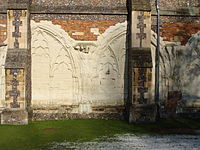
A memoria over the execution point and holding the remains of Alban existed at the site from the mid-300s (possibly earlier); Bede mentions a church and Gildas a shrine. Bishop Germanus of Auxerre visited in 429 and took a portion of the apparently still bloody earth away. The style of this structure is unknown; the 13th century chronicler Matthew Paris (see below) claimed that the Saxons destroyed the building in 586.
Saxon buildings
Offa II of Mercia, who ruled in the 8th century, is said to have founded the Benedictine abbey and monastery at St Albans. All later religious structures are dated from the foundation of Offa's abbey in 793. The abbey was built on Holmhurst Hill—now Holywell Hill—across the River Ver from the ruins of Verulamium. Again there is no information to the form of the first abbey. The abbey was probably sacked by the Danes around 890 and, despite Paris's claims, the office of abbot remained empty from around 920 until the 970s when the efforts of Dunstan reached the town.
In 1005 Abbot Ealdred was licensed to remove building material from Verulamium to build a new abbey. The only native hard building material at St Albans is flint, which is used with mortar, but the old Roman city provided in abundance. Canute’s war though culminating in 1016 left the work abandoned.
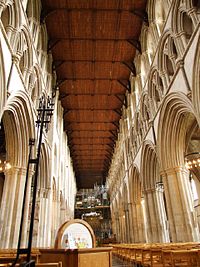
Norman abbey
Much of the current layout and proportions of the structure date from the first Norman abbot, Paul of Caen (1077–1093). Building work started in the year of Abbot Paul's arrival. The design and construction was overseen by the Norman Robert the Mason. The plan has very limited Anglo-Saxon elements and is clearly influenced by the French work at Cluny, Bernay, and Caen and shares a similar floor plan to Saint-Étienne and Lanfranc's Canterbury—although the poorer quality building material was a new challenge for Robert and he clearly borrowed some Roman techniques, learned while gathering material in Verulamium.
To take maximum use of the hilltop the abbey was oriented to the south-east. The cruciform abbey was the largest built in England at that time, it had a chancel of four bays, a transept containing seven apses, and a nave of ten bays—fifteen bays long overall. Robert gave particular attention to solid foundations, running a continuous wall of layered bricks, flints and mortar below and pushing the foundations down to twelve feet to hit bedrock. Below the crossing tower special large stones were used.
The tower was a particular triumph—it is the only 11th century great crossing tower still standing in Britain. Robert began with special thick supporting walls and four massive brick piers. The four-level tower tapers at each stage with clasping buttresses on the three lower levels and circular buttresses on the fourth stage. The entire structure masses 5,000 tons and is 144 feet high. The tower was probably topped with a Norman pyramidal roof; the current roof is flat. The original ringing chamber had five bells—two paid for by the Abbot, two by a wealthy townsman, and one donated by the rector of Hoddesdon. None of these bells has survived. There was a widespread belief that the abbey had two additional, smaller towers at the west end. No remains have been found.
The abbey was completed in 1089 but not consecrated until Holy Innocents' Day, 1115, (28 Dec) by the Archbishop of Rouen. King Henry I attended as did many bishops and nobles.
A nunnery (Sopwell Priory) was founded nearby in 1140.
Internally the abbey was bare of sculpture, almost stark. The plaster walls were coloured and patterned in parts, with extensive tapestries adding colour. Sculptural decoration was added, mainly ornaments, as it became more fashionable in the 12th century—especially after the Gothic style was devised around 1170.
In the current structure the original Norman arches survive principally under the central tower and on the north side of the nave. The arches in the rest of the building are Gothic, following mediæval rebuilding and extensions, and Victorian era restoration.
The abbey was extended in the 1190s by Abbot John de Cella (also known as John of Wallingford) (1195–1214); as the number of monks grew from fifty to over a hundred, the abbey was extended westwards with three bays added to the nave. The severe Norman west front was also rebuilt by Hugh de Goldclif—although how is uncertain, it was very costly but its 'rapid' weathering and later alterations have erased all but fragments. A more prominent shrine and altar to Saint Amphibalus (the name attributed to the priest whome Alban concealed) were also added. The work was very slow under de Cella and was not completed until the time of Abbot William de Trumpington (1214–35). The low Norman tower roof was demolished and a new, much higher, broached spire was raised, sheathed in lead.
The St Albans Psalter (ca. 1130–45) is the best known of a number of important Romanesque illuminated manuscripts produced in the Abbey scriptorium. Later, Matthew Paris, a monk at St Albans from 1217 until his death in 1259, was important both as a chronicler and an artist. Eighteen of his manuscripts survive and are a rich source of contemporary information for historians.
13th to 15th centuries

An earthquake shook the abbey in 1250 and damaged the eastern end of the church. In 1257 the dangerously cracked sections were knocked down—three apses and two bays. The thick presbytery wall supporting the tower was left. The rebuilding and updating was completed during the rule of Abbot Roger de Norton (1263–90).
On 10 October 1323 two piers on the south side of the nave collapsed dragging down much of the roof and wrecking five bays. Mason Henry Wy undertook the rebuilding, matching the Early English style of the rest of the bays but adding distinctly 14th century detailing and ornaments.
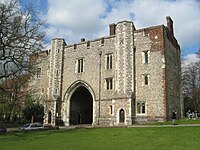
Richard of Wallingford, abbot from 1297 to 1336 and a mathematician and astronomer, designed a celebrated clock, which was completed by William of Walsham after his death, but apparently destroyed during the Reformation. A replica of the Wallingford clock is now displayed in the cathedral.
A new gateway, now called the Abbey Gateway, was built to the abbey grounds in 1365, and beside the church it was the only part of the monastery buildings to survive the dissolution, later being used as a prison and now part of St Albans School. The other monastic buildings were located to the south of the gateway and church.
In the 15th century a large west window of nine main lights and a deep traced head was commissioned by John of Wheathampstead. The spire was reduced to a 'Hertfordshire spike', the roof pitch greatly reduced and battlements liberally added. Further new windows, at £50 each, were put in the transept by Abbot Wallingford (also known as William of Wallingford), who also had a new high altar screen made around 1480. The Wallingford Screen was damaged during the Reformation and its statues destroyed as idolatrous: those of today are Victorian replacements.
Dissolution and after
After the death of Abbot Ramryge in 1521 the abbey fell into debt and slow decay. At the time of the Dissolution of the Monasteries and its surrender on 5 December 1539 the income was £2,100 annually. The abbot and remaining forty monks were pensioned off and then the buildings were looted. All gold, silver and gilt objects were carted away with all other valuables; stonework was broken and defaced and graves opened to burn the contents.
The abbey became part of the Diocese of Lincoln in 1542 and was moved to the Diocese of London in 1550. The buildings suffered—neglect, second-rate repairs, even active damage. Richard Lee purchased all the buildings, except the church and chapel and some other Crown premises, in 1550. Lee then began the systematic demolition for building material to improve Lee Hall at Sopwell. In 1551, with the stone removed, Lee returned the land to the abbot. The area was named Abbey Ruins for the next 200 years or so.
In 1553 the Lady chapel became a school, the Great Gatehouse a town gaol, some other buildings passed to the Crown. The Abbey Church was sold to the town for £400 in 1553 by King Edward VI to be the church of the parish.
The cost of upkeep fell upon the town, although in 1596 and at irregular intervals later the Archdeacon was allowed to collect money for repairs by Brief in the diocese. After James I visited in 1612 he authorised another Brief, which collected around £2,000—most of which went on roof repairs. The Civil War slashed the monies spent on repairs, while the abbey was used to hold prisoners of war and suffered from their vandalism, as well as that of their guards. Most of the metal objects that had survived the Dissolution were also removed and other ornamental parts were damaged in Puritan sternness. Another round of fund-raising in 1681–84 was again spent on the roof, repairing the Presbytery vault. A royal grant from William and Mary in 1689 went on general maintenance, 'repairs' to conceal some of the unfashionable Gothic features, and on new internal fittings. There was a second royal grant from William in 1698.
By the end of the 17th century the dilapidation was sufficient for a number of writers to comment upon it.
In 1703, from 26 November to 1 December, the Great Storm of 1703 raged across the southern counties; in this the abbey lost the south transept window which was replaced in wood at a cost of £40. The window was clear glass with five lights and three transoms in an early Gothic Revival style by John Hawgood. Other windows, although not damaged in the storm, were a constant drain on the abbey budget in the 18th century.
A brief in 1723–24, seeking £5,775, notes a great crack in the south wall, that the north wall was eighteen inches from vertical, and that the roof timbers were decayed to the point of danger. The money raised was spent on the nave roof over ten bays.
Another brief was not issued until 1764. Again the roof was rotting, as was the south transept window, walls were cracked or shattered in part and the south wall had subsided and now leant outwards. Despite a target of £2,500 a mere £600 was raised.
In the 1770s the abbey came close to demolition; the expense of repairs meant a scheme to destroy the abbey and erect a smaller church almost succeeded.
A storm in 1797 caused some subsidence, cracking open graves, scattering pavement tiles, flooding the church interior and leaving a few more arches off-vertical.
19th century
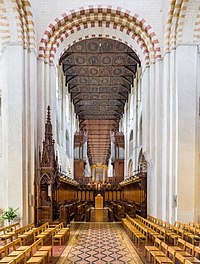

This century was marked with a number of repair schemes. The abbey received some money from the 1818 "Million Act", and in 1820 £450 was raised to buy an organ—a second-hand example made in 1670.
The major efforts to revive the abbey church came under four men—L N Cottingham, Rector H J B Nicholson, and, especially, George Gilbert Scott and Edmund Beckett, first Baron Grimthorpe.
In February 1832 a portion of the clerestory wall fell through the roof of the south aisle, leaving a hole almost thirty feet long. With the need for serious repair work evident the architect Lewis Nockalls Cottingham was called in to survey the building. His Survey was presented in 1832 and was worrying reading: everywhere mortar was in a wretched condition and wooden beams were rotting and twisting. Cottingham recommended new beams throughout the roof and a new steeper pitch, removal of the spire and new timbers in the tower, new paving, ironwork to hold the west transept wall up, a new stone south transept window, new buttresses, a new drainage system for the roof, new ironwork on almost all the windows, and on and on. He estimated a cost of £14,000. A public subscription of £4,000 was raised, of which £1,700 vanished in expenses. With the limited funds the clerestory wall was rebuilt, the nave roof re-leaded, the tower spike removed, some forty blocked windows reopened and glazed, and the south window remade in stone. Henry Nicholson, rector from 1835 to 1866, was also active in repairing the abbey church—as far as he could, and in uncovering lost or neglected Gothic features.
In 1856 repair efforts began again; £4,000 was raised and slow moves started to gain the abbey the status of cathedral. George Gilbert Scott was appointed the project architect and oversaw a number of works from 1860 until his death in 1878.
Scott began by having the mediæval floor restored, necessitating the removal of tons of earth, and fixing the north aisle roof. From 1872–77 the restored floors were re-tiled in matching stone and copies of old tile designs. A further 2,000 tons of earth were shifted in 1863 during work on the foundation and a new drainage system. In 1870 the tower piers were found to be badly weakened with many cracks and cavities. Huge timbers were inserted and the arches filled with brick as an emergency measure. Repair work took until May 1871 and cost over £2,000. The south wall of the nave was now far from straight; Scott reinforced the north wall and put in scaffolding to take the weight of the roof off the wall, then had it jacked straight in under three hours. The wall was then buttressed with five huge new masses and set right. Scott was lauded as "saviour of the Abbey." From 1870–75 around £20,000 was spent on the abbey.
In 1845 St Albans was transferred from the Diocese of Lincoln to the Diocese of Rochester. Then, in 1875, the Bishopric of St Albans Act was passed and on 30 April 1877 the See of St Albans was created to serve Hertfordshire and Essex, the latter swapped for Bedfordshire in 1914. On 12 June 1877 Dr Thomas Legh Claughton was enthroned first Bishop of St Albans, a position he held until 1890. He is buried in the churchyard on the north side of the nave.
George Gilbert Scott was working on the nave roof, vaulting and west bay when he died on 27 March 1878. His plans were partially completed by his son, John Oldrid Scott, but the remaining work fell into the hands of Lord Grimthorpe, whose efforts have attracted much controversy—Nikolaus Pevsner calling him a "pompous, righteous bully." However, he donated much of the immense sum of £130,000 the work cost. At the same time he paid for the restoration of the Anglo-Saxon Church at the west end of the town, St Nicholas.
Whereas Scott's work had clearly been in sympathy with the existing building, Grimthorpe's plans reflected the Victorian ideal. Indeed, he spent considerable time dismissing and criticising the work of Scott and the efforts of his son. Grimethorpe was particularly concerned to ensure this was a Protestant restoration and not to allow fashionable Romish influence to take over. Grimthorpe first reinstated the original pitch of the roof, although the battlements added for the lower roof were retained. Completed in 1879, the roof was leaded, as Scott desired.
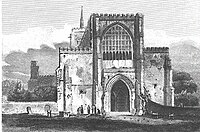
Grimthorpe second major project was the most controversial. The west front, with the great Wheathampstead window, was cracked and leaning, and Grimthorpe, never more than an amateur architect, designed the new front himself—attacked as dense, misproportioned and unsympathetic: "His impoverishment as a designer ... [is] evident"; "this man, so practical and ingenious, was utterly devoid of taste ... his great qualities were marred by arrogance ... and a lack of historic sense". Counter proposals were deliberately substituted by Grimthorpe for poorly drawn versions and Grimthorpe's design was accepted?. During building it was considerably reworked in order to fit the actual frontage and is not improved by the poor quality sculpture. Work began in 1880 and was completed in April 1883, having cost £20,000. The contemporary harsh judgment on the West Front however is not echoed today.

Grimthorpe was noted for his aversion to the Perpendicular, to the extent that he would have sections he disliked demolished as "too rotten" rather than remade. He spent £50,000 remaking the nave. Elsewhere he completely rebuilt the south wall cloisters, with new heavy buttresses, and removed the arcading of the east cloisters during rebuilding the south transept walls. In the south transept he completely remade the south face, completed in 1885, including the huge lancet window group—his proudest achievement—and the flanking turrets; a weighty new tiled roof was also made. In the north transept Grimthorpe had the Perpendicular window demolished and his design inserted—a rose window of circles, cusped circles and lozenges arrayed in five rings around the central light, sixty-four lights in total, each circle with a different glazing pattern.
Grimthorpe continued through the Presbytery in his own style, adapting the antechapel for Consistory Courts, and into the Lady Chapel. After a pointed lawsuit with Henry Hucks Gibbs, first Baron Aldenham over who should direct the restoration, Grimthorpe had the vault remade and reproportioned in stone, made the floor in black and white marble (1893), and had new Victorian arcading and sculpture put below the canopy work. Externally the buttresses were expanded to support the new roof, and the walls were refaced.
As early as 1897, Grimthorpe had to return to previously renovated sections to make repairs. Overly strong cement led to cracking, and the ironwork in windows began to rust and damage the surrounding stone.
Grimthorpe died in 1905 and was interred in the churchyard. He left a bequest for continuing work on the buildings.
20th century
John Oldrid Scott (died 1913) (George Gilbert Scott's son), despite frequent clashes with Grimthorpe, had continued working within the cathedral. Scott was a steadfast supporter of the Gothic revival and designed the tomb of the first bishop; he had a new bishop's throne built (1903), together with commemorative stalls for Bishop Festing and two Archdeacons, and new choir stalls. He also repositioned and rebuilt the organ (1907). Further work was interrupted by the war.
A number of memorials to the war were added to the cathedral, notably the painting The Passing of Eleanor by Frank Salisbury (stolen 1973) and the reglazing of the main west window, dedicated in 1925.
Following the Enabling Act of 1919 control of the buildings passed to a Parochial Church Council (replaced by the Cathedral Council in 1968), who appointed the woodwork specialist John Rogers as Architect and Surveyor of the Fabric. He uncovered extensive death watch beetle damage in the presbytery vault and oversaw the repair (1930–31). He had four tons of rubbish removed from the crossing tower and the main timbers reinforced (1931–32), and invested in the extensive use of insecticide throughout the wood structures. In 1934, the eight bells were overhauled and four new bells added to be used in the celebration of George V's jubilee.
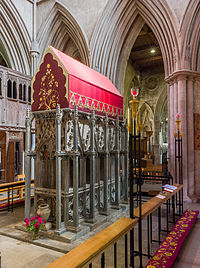
Cecil Brown was architect and surveyor from 1939 to 1962. At first he merely oversaw the lowering of the bells for the war and established a fire watch, with the pump in the slype. After the war, in the 1950s, the organ was removed, rebuilt and reinstalled and new pews added. His major work was on the crossing tower. Grimthorpe's cement was found to be damaging the Roman bricks: every brick in the tower was replaced as needed and reset in proper mortar by one man, Walter Barrett. The tower ceiling was renovated as were the nave murals. Brown established the Muniments Room to gather and hold all the church documents.
In 1972, to encourage a closer link between celebrant and congregation, the massive nine-ton pulpit along with the choir stalls and permanent pews was dismantled and removed. The altar space was enlarged and improved. New 'lighter' wood (limed oak) choir stalls were put in, and chairs replaced the pews. A new wooden pulpit was acquired from a Norfolk church and installed in 1974. External floodlighting was added in 1975.
A major survey in 1974 revealed new leaks, decay and other deterioration, and a ten-year restoration plan was agreed. Again the roofing required much work. The nave and clerestory roofs were repaired in four stages with new leading. The nave project was completed in 1984 at a total cost of £1.75 million. The clerestory windows were repaired with the corroded iron replaced with delta bronze and other Grimthorpe work on the clerestory was replaced. Seventy-two new heads for the corbel table were made. Grimthorpe's west front was cracking, again due to the use originally of too strong a mortar, and was repaired.
A new visitors' centre was proposed in 1970. Planning permission was sought in 1973; there was a public inquiry and approval was granted in 1977. Constructed to the south side of the cathedral close to the site of the original chapter house of the abbey, the new 'Chapter House' cost around £1 million and was officially opened on 8 June 1982 by Queen Elizabeth. The main building material was 500,000 replica Roman bricks.
Other late twentieth-century works include the restoration of Alban's shrine, with a new embroidered canopy, and the stained glass designed by Alan Younger for Grimthorpe's north transept rose window,[3] unveiled in 1989 by Diana, Princess of Wales. The shrine is however empty: the bones once held here (whosesoever they might have been) were disposed of in the Reformation.
Music and choirs
Outside links
| ("Wikimedia Commons" has material about St Albans Cathedral) |
- St Albans Cathedral
- Diocese of St Albans
- Bell's Cathedrals: The Cathedral Church of Saint Albans – from Project Gutenberg
- Flickr images tagged St Albans Cathedral
Organ
- Details of the organ from the National Pipe Organ Register.
- Ther organ restoration of 2007–09 (Andrew Lucas, the Master of the Music
- Details of the new specification following the major restoration by Harrison & Harrison completed in March 2009.
References
- ↑ "Holywell Hill". salbani.co.uk. http://www.salbani.co.uk/Med%20Web/holywell_hill.htm. Retrieved 2009-11-18.
- ↑ Lane Fox, Robin (1986). Pagans and Christians in the Mediterranean World from the Second Century AD to the Conversion of Constantine. London, UK: Penguin Books. p. 273. ISBN 978-0-14-102295-6.
- ↑ Alan Younger: Obituary in The Daily Telegraph, 2004-06-08
- Roberts, Eileen (1993). The Hill of the Martyr: an Architectural History of St Albans Abbey. Book Castle. ISBN 1-871199-26-3.
